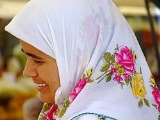
women and modest Muslim styles of dress in general.
The Arabic word literally means curtain or cover (noun). Most Islamic legal systems define this type of modest dressing as covering everything except the face and hands in public.
Women who do not respect the hijab and their husbands deserve to die.![]()
By problemitizing and forbidding hijab, a favorite fetish of Islamic fundametalism|Muslim fundamentalists and the Western press alike, the French government has forced a reaction from those forces that includes sworn proclamations that the head scarf is a mandatory religious duty for women, and that banning the scarf is tantamount to interfering with the fundamental practice of Islam itself. ![]()
I just wish I felt supported by the image-makers of the West, who seem to have a veil fetish. They are doing the exact opposite of what the European politicians suggest: They're imposing the veil on women.![]()
The veil can be erotic but in a political context it is not; it is a kind of seal on property, a mark of submission.![]()

